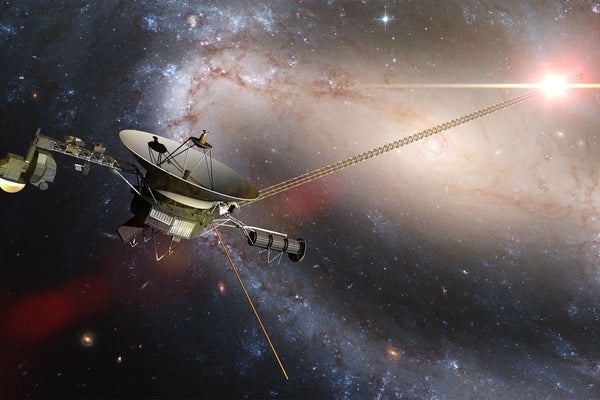Voyager 1’s Revival Offers Inspiration for Everyone on Earth
Instruments may fail, but humanity’s most distant sentinel will keep exploring, and inspiring us all

Artist’s rendering of a Voyager spacecraft in deep space.
Dotted Zebra/Alamy Stock Photo
Amid April’s litany of bad news—war in Gaza, protests on American campuses, an impasse in Ukraine—a little uplift came for science buffs.
NASA has reestablished touch with Voyager 1, the most distant thing built by our species, now hurtling through interstellar space far beyond the orbit of Pluto. The extraordinarily durable spacecraft had stopped transmitting data in November, but NASA engineers managed a very clever work-around, and it is sending data again. Now more than 15 billion miles away, Voyager 1 is the farthest human object, and continues to speed away from us at approximately 38,000 miles per hour.
Like an old car that continues to run, or an uncle blessed with an uncommonly long life, the robotic spacecraft is a super ager that goes on and on—and, in doing so, has captivated space buffs everywhere.
On supporting science journalism
If you’re enjoying this article, consider supporting our award-winning journalism by subscribing. By purchasing a subscription you are helping to ensure the future of impactful stories about the discoveries and ideas shaping our world today.
Launched on September 5, 1977, the one-ton Voyager 1 was meant to chart the outer solar system, in particular the gas giant planets Jupiter and Saturn, and Saturn’s moon, Titan. Its twin, Voyager 2, launched the same year, followed a different trajectory with a slightly different mission to explore the outer planets before heading to the solar system’s edge.
Those were NASA’s glory days. A few years earlier, NASA had successfully landed men on the moon—and won the space race for the U.S. NASA’s engineers were the envy of the world.
To get to Jupiter and Saturn, both Voyagers had to traverse the asteroid belt, which is full of rocks and debris orbiting the sun. They had to survive cosmic rays, intense radiation from Jupiter and other perils of space. But the two spacecraft made it without a hitch.
President Jimmy Carter held office when Voyager 1 was launched from Cape Canaveral; Elvis Presley had died just three weeks before; gas was about 60 cents a gallon; and, like now, the Middle East was in crisis, with Israeli Prime Minister Menachem Begin and Egyptian President Anwar Sadat trying to find peace.
Voyager 1 sent back spectacular photos of Jupiter and its giant red spot. It showed how dynamic the Jovian atmosphere was, with clouds and storms. It also took pictures of Jupiter’s moon Io, with its volcanoes, and Saturn’s moon Titan, which astronomers think has an atmosphere similar to the primordial Earth’s. The spacecraft discovered a thin ring around Jupiter and two new Jovian moons, which were named Thebe and Metis. On reaching Saturn, it discovered five new moons as well as a new ring.
And then Voyager 1 continued on its journey and sent images back from the edge of the solar system. Many of us remember the Pale Blue Dot, a haunting picture of the Earth it took on Feb 14, 1990, when it was a distance of 3.7 billion miles from the sun. The astronomer Carl Sagan wrote:
“There is perhaps no better demonstration of the folly of human conceits than this distant image of our tiny world. To me, it underscores our responsibility to deal more kindly with one another, and to preserve and cherish the pale blue dot, the only home we’ve ever known.”
By then Voyager 1 had long outlived its planetary mission but kept faithfully calling home as it traveled beyond the solar system into the realm of the stars. By 2012 Voyager 1 had reached the heliosphere, the farthest edge of the solar system. There, it penetrated the heliopause, where the solar wind ends, stopped by particles coming from the interstellar medium, the vast space between the stars. (Astronomers know that the space between the stars is not totally empty but permeated by a rarefied gas.)
From Voyager 1, scientists learned that the heliopause is quite dynamic and first measured the magnetic field of the Milky Way beyond the solar system. And its instruments kept sending data as it traveled through the interstellar medium.
On hearing that Voyager 1 had gone dark, I had checked in with Louis Lanzerotti, a former Bell Labs planetary scientist who did the calibrations for the Voyager 1 spacecraft and was a principal investigator on many experiments. He told me that a NASA manager in the 1970s had doubted that the spacecraft’s mechanical scan platform, which pointed instruments at targets, and very thin solid state detectors, which took those edge of the solar system readings, on the spacecraft would survive. They not only survived but worked flawlessly for all this time, Lanzerotti said, providing excellent data for decades. He was overjoyed on hearing the news that Voyager 1 was still alive.
Voyager 1 instruments have power until 2025. After that, they will shut off, one by one. But there is nothing to stop the spacecraft as it speeds away from us in the vast emptiness of space.
Thousands of years from now, maybe when the human race has left this planet, Voyager 1, the tiny little spacecraft that could, will still continue its inexorable journey to the stars.
This is an opinion and analysis article, and the views expressed by the author or authors are not necessarily those of Scientific American.
